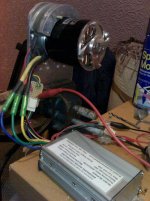Jeremy Harris
100 MW
Thanks Methods. There is so much really useful stuff in posts on here that it's easy to miss, but I guess there was no good reason for me not looking in the obvious place first..............
Overall, I'm happy with the 110% setting, as it gives about 95% power at full throttle without any glitching, which is OK for what I need. My guess is that this will be very motor/controller combination sensitive, so most may just want to stay at the 100% setting and put up with the small loss in top end power.
Jeremy
Overall, I'm happy with the 110% setting, as it gives about 95% power at full throttle without any glitching, which is OK for what I need. My guess is that this will be very motor/controller combination sensitive, so most may just want to stay at the 100% setting and put up with the small loss in top end power.
Jeremy


